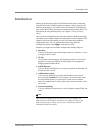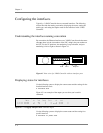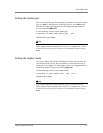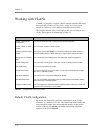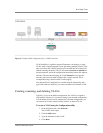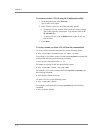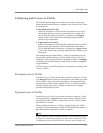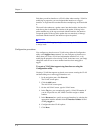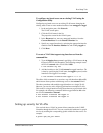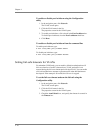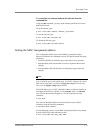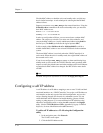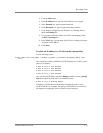
Post-Setup Tasks
3-DNS
®
Administrator Guide 4 - 7
Configuring packet access to VLANs
The 3-DNS Controller supports two methods for sending and receiving
packets through an interface that is a member of one or more VLANs. These
two methods are:
◆ Port-based access to VLANs
Packets are accepted for a VLAN because the packets have no tags in
their headers and were received on an interface that is a member of a
VLAN. With this method, an interface is configured as an untagged
member of the VLAN. Packets sent out through untagged interfaces
contain no tag in their header.
◆ Tag-based access to VLANs
Packets are accepted for a VLAN because the packets have tags in their
headers and the tag matches the VLAN identification number for the
VLAN. With this method, an interface is configured as a tagged member
of the VLAN. Packets sent out through tagged interfaces contain a tag in
their header.
The sending/receiving method used by a VLAN is determined by the way
that you add a member interface to a VLAN. When creating a VLAN or
modifying VLAN properties (using the Configuration utility or the bigpipe
command), you can add an interface to that VLAN as either an untagged or
a tagged interface.
The following two sections describe these two methods of providing packet
access to a VLAN.
Port-based access to VLANs
Port-based access to VLANs occurs when an interface is added to a VLAN
as an untagged interface. In this case, the interface can be added only to that
VLAN and to no others. This limits the interface to accepting traffic only
from that VLAN, instead of from multiple VLANs. To solve this problem,
3-DNS Controller allows you to configure a feature known as tagging,
described in the following section.
Tag-based access to VLANs
Tag-based access to VLANs occurs when an interface is added to a VLAN
as a tagged interface. A tagged interface can be added to multiple VLANs,
thereby allowing the interface to accept traffic from each VLAN of which
the interface is a member.
When you add an interface to a VLAN as a tagged interface, the 3-DNS
Controller associates the interface with the VLAN identification number, or
tag, which becomes embedded in a header of a packet.
Note
Every VLAN has a VLAN identification number. This identification number
is assigned to a VLAN either explicitly by a user when creating the VLAN,
or automatically by the 3-DNS Controller if the user does not supply one.





